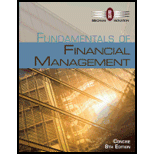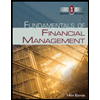
DIVIDEND POLICY Southeastern Steel Company (SSC) was formed 5 years ago to exploit a new continuous casting process. SSC’s founders, Donald Brown and Margo Valencia, had been employed in the research department of a major integrated-steel company; but when that company decided against using the new process (which Brown and Valencia tad developed), they decided to strike out on their own. One advantage of the new process was that it required relatively little capital compared to the typical Steel company, so Brown and Valencia have been able to avoid issuing new stock and thus own all of the shares. However, SSC has now reached the stage in which outside equity capital is necessary if the firm is to achieve its growth targets yet still maintain its target capital structure of 60% equity and 40% debt. Therefore, Brown and Valencia have decided to take the company public. Until now, Brown and Valencia have paid them-selves reasonable salaries but routinely reinvested all after tax comings in the firm; so the firm’s dividend policy has not been an issue. However, before talking with potential outside investors, they must decide on a dividend policy.
Assume that you were recently hired by Arthur Adamson & Company (AA), a national consulting firm, which has been asked to help SSC prepare for its public offering. Martha Millon, the senior AA consultant in your group, has asked you to make a presentation to Brown and Valencia in which you review the theory of dividend policy and discuss the following questions:
a. 1. What is meant by the term dividend polity?
2. Explain briefly the dividend irrelevance theory that was put forward by Modigliani and Miller. What were the key assumptions underlying their theory?
3. Why do some investors prefer high-dividend-paying stocks, while other investors
b. Discuss (1) the information content, or signaling, hypothesis; (2) the clientele effect; (3) catering theory; and (4) their effects on dividend policy.
c. 1. Assume that SSC has an $800,000 capital budget planned for the coming year. You have determined that its present capital structure (60% equity and 40% debt) is optimal, and its net income is
2. In general terms, how would a change in investment opportunities affect the payout ratio under the residual dividend model?
3. What are the advantages and disadvantages of the residual policy? (Hint: Don’t neglect signaling and clientele effects.)
d. Describe the series of steps that most firms lake in setting dividend policy in practice.
e. What is a dividend reinvestment plan (DRIP), and how does it work?
f. What are stock dividends and stock splits? What are the advantages and disadvantages of stock dividends and stock splits?
g. What are stock repurchases? Discuss the advantages and disadvantages of a firm’s repurchasing its own shares.
Trending nowThis is a popular solution!

Chapter 14 Solutions
Fundamentals of Financial Management, Concise Edition (with Thomson ONE - Business School Edition, 1 term (6 months) Printed Access Card) (MindTap Course List)
- D Plc is in the process of making a 1 for 4 rights issue. The rights letters have just been sent to shareholders. The company currently has 20m K1 shares in issue and the current market price is K4.50 per share. The rights letter gives shareholders the right to buy their new shares for K3.50 each. D Plc plans to use the cash raised to build a major extension to its factory, thereby doubling production capacity. The finance director has received an angry letter from a shareholder. The shareholder complains that he cannot afford to invest in new shares. He contends that he is likely to suffer a loss because of the fact that the market will be flooded with cheap shares as the issue will almost certainly decrease the value of his holding. Required: I. Calculate the value at which the share price is likely to settle after the rights issue. II. Explain whether the shareholder’s complaint is justified with particular reference to the difference between the rights price and the current…arrow_forwardMini Case Your employer, a midsized human resources management company, is considering expansion into related fields, including the acquisition of Temp Force Company, an employment agency that supplies word processor operators and computer programmers to businesses with temporarily heavy workloads. Your employer is also considering the purchase of Biggerstaff & McDonald (B&M), a privately held company owned by two friends, each with 5 million shares of stock. B&M currently has free cash flow of $24 million, which is expected to grow at a constant rate of 5%. B&M’s financial statements report short-term investments of $100 million, debt of $200 million, and preferred stock of $50 million. B&M’s weighted average cost of capital (WACC) is 11%. Answer the following questions: Describe briefly the legal rights and privileges of common stockholders. What is free cash flow (FCF)? What is the weighted average cost of capital? What is the free cash flow valuation model? Use…arrow_forwardwo capital goods manufacturing companies, Rock Island and Davenport, are virtually identical in all aspects of their operations—product lines, amount of sales, total size, and so on. The two companies differ only in their capital structures, as shown here: Rock Island (millions) Davenport (millions) Debt (5%) $400 $200 Common equity $500 $700 Number of common shares outstanding 25 35 Each company has $900 billion in total assets. Capital goods manufacturers typically are subject to cyclical trends in the economy. Suppose that the EBIT level for both companies is $90 million during an expansion and $60 million during a recession. (Assume a 40% tax rate for both companies.) Calculate the earnings per share for both companies during expansion and recession. Round your answers to the nearest cent. Rock Island Davenport Expansion: $ $ Recession: $ $ Which stock is riskier? Why? is riskier because of its risk. At what EBIT…arrow_forward
- Walkure A.G., a multinational corporation from Country A, announced the relocation of its manufacturing plants from Country B to Country C. The news about the relocation was never reported in the media. The move is expected to create positive synergies, as most of the company's other manufacturing operations are based in Country C. The relocation is also expected to lead to tax benefits. The company's shares are traded in three stock exchanges in Country A, Country B, and Country C. Share prices in the three stock exchanges responded to the relocation in three different ways: Country A: The share price increased drastically after the announcement. Country B: The share price decreased drastically after the announcement. Country C: The share price increased marginally after the announcement. Based solely on the information given, which of the following statements is least likely true of the stock exchanges? The exchange in Country A is most efficient, as the market reacted…arrow_forwardCompany X generated cash flows of £20m in the last year. The company has budgeted £12m for various investment projects. At the last executive committee meeting, the CEO proposed to pay the £8m surplus as dividend, arguing that this was the best way to boost the company’s share price. Other directors replied that a share buyback would be more effective in raising the share price. The CFO suggested instead that the surplus be temporarily invested in liquid financial assets and be made available in case of new investment opportunities. In no more than 200 words evaluate these proposals using Corporate Finance theory.arrow_forwardYou work for a levered buyout firm and are evaluating a potential buyout of Boogle Inc. Boogle's stock price is $18, and it has 3 million shares outstanding. You believe that if you buy the company and replace its dismal management team, its value will increase by 50%. You are planning on doing a levered buyout of Boogle and will offer $25 per share for control of the company. Assuming you get 50% control, your gain from the transaction will be closest to: Answer choices: A) $2.0 million B) $5.0 million C) $4.7 million D) $6.0 millionarrow_forward
- Last year Mason Inc. had a total assets turnover of 1.33 and an equity multiplier of 1.75. Its sales were $215,000 and its net income was $10,549. The CFO believes that the company could have operated more efficiently, lowered its costs, and increased its net income by $5,250 without changing its sales, assets, or capital structure. Had it cut costs and increased its net income in this amount, by how much would the ROE have changed? Select the correct answer. a. 6.74% b. 6.21% c. 7.27% d. 7.80% e. 5.68%arrow_forwardThe firm Amble is entirely financed by equity. It has 4 million shares and a current share price of $8. It is public knowledge that the firm's current management is inefficient and the firm's share price would be $11 if well managed. Amble's shares are owned entirely by small shareholders. The administrative costs to acquire Amble would be $0.14 million. An acquirer can gain control of the firm and manage it efficiently if they can purchase at least 51% of its shares. Assume the market is semi-strong form efficient. (a) Lawson, an entrepreneur, can secretly buy 5% of Amble's shares at the current market price, then make a public bid for a further 46% of the total number of shares at $11 each. What is Lawson's profit? Will the takeover go ahead? Explain. (b) Assume that Lawson implements the strategy described in part (a). Amble has made a provision that when a potential acquirer reaches a holding of 16% of its shares, all shareholders except the acquirer will be able to buy one new…arrow_forwardNet Income (NI) could be thought of as earnings available for dividends to equity shareholders, assuming none is needed to sustain current operations without further growth. So, let us assume NI will be $500 in year 1 and $525 in year two. Then, the company expects to sell this division for $3,000 at the end of year 3. If the discount rate is 14%, what is the present value of this business division?arrow_forward
 Fundamentals Of Financial Management, Concise Edi...FinanceISBN:9781337902571Author:Eugene F. Brigham, Joel F. HoustonPublisher:Cengage Learning
Fundamentals Of Financial Management, Concise Edi...FinanceISBN:9781337902571Author:Eugene F. Brigham, Joel F. HoustonPublisher:Cengage Learning Fundamentals of Financial Management, Concise Edi...FinanceISBN:9781305635937Author:Eugene F. Brigham, Joel F. HoustonPublisher:Cengage Learning
Fundamentals of Financial Management, Concise Edi...FinanceISBN:9781305635937Author:Eugene F. Brigham, Joel F. HoustonPublisher:Cengage Learning Fundamentals of Financial Management, Concise Edi...FinanceISBN:9781285065137Author:Eugene F. Brigham, Joel F. HoustonPublisher:Cengage Learning
Fundamentals of Financial Management, Concise Edi...FinanceISBN:9781285065137Author:Eugene F. Brigham, Joel F. HoustonPublisher:Cengage Learning Fundamentals of Financial Management (MindTap Cou...FinanceISBN:9781337395250Author:Eugene F. Brigham, Joel F. HoustonPublisher:Cengage Learning
Fundamentals of Financial Management (MindTap Cou...FinanceISBN:9781337395250Author:Eugene F. Brigham, Joel F. HoustonPublisher:Cengage Learning Fundamentals of Financial Management (MindTap Cou...FinanceISBN:9781285867977Author:Eugene F. Brigham, Joel F. HoustonPublisher:Cengage Learning
Fundamentals of Financial Management (MindTap Cou...FinanceISBN:9781285867977Author:Eugene F. Brigham, Joel F. HoustonPublisher:Cengage Learning Financial Accounting: The Impact on Decision Make...AccountingISBN:9781305654174Author:Gary A. Porter, Curtis L. NortonPublisher:Cengage Learning
Financial Accounting: The Impact on Decision Make...AccountingISBN:9781305654174Author:Gary A. Porter, Curtis L. NortonPublisher:Cengage Learning





